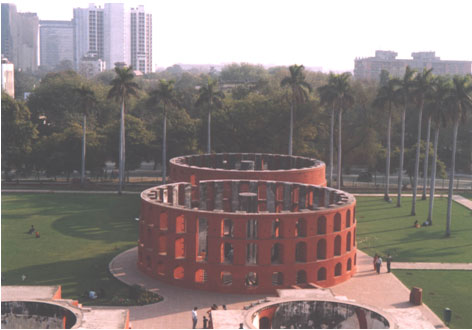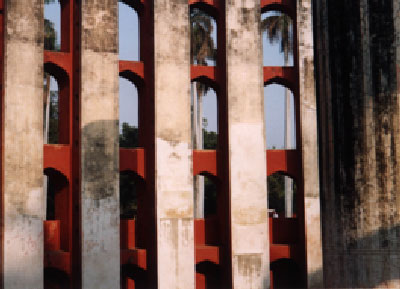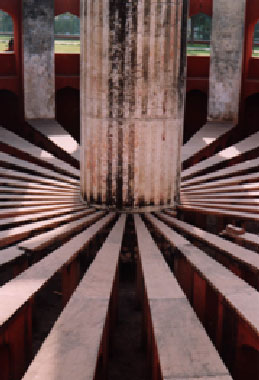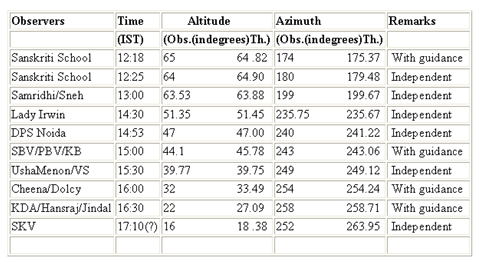|
|
Venus2004.org
> Files
3°) Observations with the Ram Yantra
Ram Yantra seems to be constructed precisely to make it very easy for any one to make local co-ordinate measurements of objects in the sky. Each of the cylindrical instruments consists of a circular wall and a gnomon at the center. The height of the walls and the gnomon, has been designed to be exactly equal to the inside radius of the building measured from the outer circumference of the thick gnomon - that is, the height of the gnomon is exactly equal to the length of the floor of the instrument measured from the outer circumference of the gnomon to the inner circumference of the wall.  Figure 4. The twin Ram Yantra instruments..© Nehru Planetarium, New Delhi, India. The walls and floor are graduated for reading Azimuth and Altitude angles - with the Azimuth markings being a linear scale in degrees, while the Altitude markings are in tangents of degrees and therefore not linearly marked. What is needed is to observe the shadow of the gnomon - determine its center and mark it on the floor or the walls of the instrument - wherever it falls.  Figure 5 a. The inner walls of the Ram Yantra. © Nehru Planetarium, New Delhi, India. The floor is divided into thirty sectors and thirty gaps of the same dimensions as the sectors. The gaps are for facilitating the movement of observers to read the markings and hence, the complimentary instrument is designed in such a way that, the shadow falls on a sector of one of the instruments, if it falls in the gap for the other instrument. Each of the sectors is thus spanning 6 degrees of Azimuth. The sectors are marked with six radial lines - so that each marking corresponds to a degree of Azimuth. Etched at about five feet above the raised floor of the instrument - on the gnomon itself, is a circular scale of Azimuth markings. The edge of one of the sectors is aligned to the North. This is marked as 360 degrees (in Hindi) on the Gnomon markings. Once the center of the gnomon shadow (this is not so straightforward and is discussed later) is determined and marked with pencil - one can just read off the Azimuth - by starting with the edge marked as 360 degrees and counting the number of sectors and gaps and individual degree markings up to the center of the shadow. A little trick here, though - the shadow marks a position exactly 180 degrees away from the actual position of Sun in the sky - and therefore 180 degrees would need to be added to the Azimuth reading obtained by counting the sectors and degree lines. Thus angles of 1 degree each can just be read off from the Azimuth markings - finer graduations seem to be missing from the Delhi instrument, in its present condition, but, temporary calibrations for finer accuracy can always be achieved using tape measure placed parallel to Azimuth circles.  5b. The raised floor of the Ram Yantra marked in sectors and gaps. © Nehru Planetarium, New Delhi, India. The walls of the instrument are also graduated similar to the floor - each of the markings representing one degree in Azimuth and one degree in Altitude. It is the Altitude markings in tangents of scale that form the beautiful simplicity of usage of this instrument. When the shadow falls at the top of the wall of the instrument the Altitude of Sun is zero. As one moves down from the top of the wall to the bottom, there are 45 markings on the wall giving rise to an altitude of 45 degrees for the Sun, if the shadow falls at the junction of the walls and the floor. Another 45 degrees are marked inward from the wall towards the circumference of the Gnomon - so that, altitudes between 45 to 90 degrees can be read off on the floor of the instrument. Finer graduations than a degree are marked on some of the sectors - where missing - one needs to remember that the scale is not linear any more (unlike for the Azimuth) and thus more accurate Altitude measurements (where fine graduations are missing) could be inferred by measuring accurately, the length of the shadow and knowing that the height of the gnomon is equal to the length of the floor sector. Tan (Altitude) = Gnomon Height / Shadow Length It is interesting to think of the accuracies possible with this instrument - a first time observer, initially, feels rather disheartened due to the uncertainties in estimating the center of the Gnomon Shadow, the blurring between the Umbra and the Penumbra and so on. But, simply because the instrument is built on such a massive scale - the errors induced by these uncertainties are minimal and wonderful accuracies (for educational purposes) can be achieved with this instrument. In the observations undertaken in all of this work, the Altitudes involved have been large enough that refraction corrections in the estimation of the correct Altitude have been ignored. Some of the results from the observations on the 29th of March 2004 –  1. Sanskriti School - Teachers – Champa Biswas and Nidhi Kaucha and students 2. Samridhi/Sneh – Samridhi, Lady Irwin Sen. Sec. School and Sneh Kesari Nutan Marathi Sen. Sec. School. 3. Lady Irwin – Rupal Kashyap and Purnima Kashyap 4. DPS Noida – Arun Kumar, Head Physics Department 5. SBV/PBV/KB – Students of SBV Subhash Nagar, Pratibha Vikas Vidyalaya and Krishi Bihar 6. Usha Menon/VS – Usha Menon – Rolls Royce India and Dr. Vinay Sharma of Pt. GLM Sharma Hospital 7. Cheena/Dolcy – Cheena Dang – Polytechnic student and Dolcy Chabra of Imperial Academy school, Indore. 8. KDA/Hansraj/Jindal – Sivaramakrishnan, and Kartik of KD Ambani Vidyamandir, Jamnagar, Gujrat, Archit Babbar of NC Jindal public school, Delhi and Mukul Agarwal of Hansraj Public school, Delhi. 9. SKV – SKV public school, Delhi.  1. Public – Acharya Anand Sagar, Dr. Vinay Kumar, Mangal Singh and others present. 2. Sanat/Vikrant – Sanath Kumar, Nehru Planetarium and Vikrant Narang, Amateur Astronomers Association, New Delhi. 3. Sirius Group – Abhishek Tibrewal, Sapna Tibrewal, Shikha Rao, Shweta Chaurasia. 4. Samridhi/Sneh - Samridhi, Lady Irwin Sen. Sec. School and Sneh Kesari Nutan Marathi Sen. Sec. School. In conclusion, it emerges that even in their current state of disrepair, the two instruments Jayaprakas and Ram Yantra could easily be used with good accuracies for many possible student projects that can be done with simple celestial measurements. |
|
© 2003-2006 Futura-Sciences.com. All rights reserved.
Indexator - Comparateur de prix - Revue de Presse
